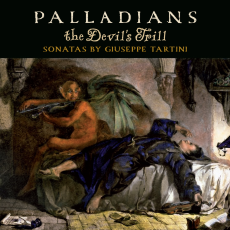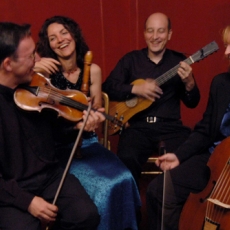Giuseppe Tartini - Palladians - Atlanta Audio Society
Violinist Rodolfo Richter gives compelling ultra-Baroque style performances of Italian sonatas, including as the poster child of the recital the famous Sonata in g minor of Giuseppe Tartini, known as the "Devil's Trill." He is ably seconded by his fellow Palladians, Susanne Heinrich (viola da gamba), William Carter (archlute and guitar) and Silas Standage (harpsichord).
The nickname of this sonata comes from the legend, promulgated by Tartini himself, that he sold his soul to the Devil in a dream in exchange for the technique needed to perform the ever-rising circles of trills, self-accompanied by passages that could only be described as mocking diabolical laughter, that made the work such a sensation. As it has long been absorbed into the standard repertoire for violin virtuosi. In fact, this was the first time I'd ever heard it played on a Baroque as opposed to a modern instrument (Richter plays an Andrea Guarneri, Cremona 1674), and it came as both a revelation and a shock.
To begin with, the period instrument proved much slower than its modern counterpart, and did not rise to the stratospheric heights to which I was used in violinists from Nathan Milstein and Henry Szeryng to the present day. Richter makes his points by stressing what the Baroque instrument does best: its distinctively warm, rich sound, best heard in the sighing intonations in the opening Larghetto, marked Affetuoso, and its ability to leap registers, which Richter does sensationally in the spirited finale.
If feeling comes first, Richter and his friends get an "A" for this sonata and also for Tartini's other Sonata in g minor, known as "Didone abbandonata" (Dido abandoned). Carter, in his informative program notes, rightly describes this sonata as an even greater example of Tartini''s art for its psychological realism. The three movements describe (1) Dido's emotions on discovering that Aeneas has left her: anxious longing, memories of past happiness, and hopefulness for the future; (2) rage when the reality finally sinks in; and (3) her determination, reinforced by the bleak tonality in the melody, to end her life. It is a magnificent portrait of a proud queen choosing death over disgrace.
Veracini is represented by his Sonata in A Major, Op. 7, of which I had previously known only the deeply moving Largo. It may be the crown jewel of the diadem, but, as the Palladians demonstrate, it is far from its sole beauty, as Veracini skillfully programs five movements (Cantabile, Larghetto, Allegro, Largo, Allegro) to bring out the striking contrasts of rhythm and mood.
That isn't all. Tartini's Sonata in A Major, the "Pastorale," allows the Palladians to relish the high-spirited rhythms of the Allegro and Richter to cultivate the silvery sheen of the violin part. The work ends on a curiously subdued mood, perhaps a note of regret for the moment when enchanted Spring gives way, as it typically does in Italy, to a less-than-enchanting Summer.

